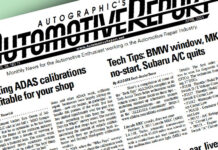By John Yoswick
Over the 10 years Jeff Parker had operated his West Coast collision repair business, inspectors from the Occupational Safety and Health Administration (OSHA) had visited three times. So in 2014 when one of his employees called as Parker was driving to the shop to say there was an OSHA inspector waiting for him, Parker told the employee to go ahead and show the inspector around.
“We have a clean, safe shop, with nothing to hide,” said Parker, who asked that his real name not be used. “In the past, someone would show the inspector through the shop, they’d make some notes and come talk to me about it, and we’d be good to go. But I could tell this was different, right from the start. This guy refused to leave the chair to inspect the shop until I got here.”
Parker was right that this OSHA visit wasn’t like those he’d previously experienced at his 15,000-square-foot suburban shop. As part of a three-year emphasis (ending this year) on protecting workers from isocyanate exposure, OSHA is doing comprehensive testing and inspections within body shops around the country. The inspector that came to Parker’s shop spent three days there, interviewing employees, doing swab-testing of surfaces, putting monitors on workers, and reviewing all of the shop’s paperwork related to safety.
“It was different from anything I’ve seen in 30 years working in this industry,” Parker said.
Here’s what shop owners should know about the stepped-up OSHA inspections, along with advice from shop owners and consultants about ensuring your business is in safety and environmental regulatory compliance.
Testing for isocyanates
Isocyanates are a family of chemicals found in some paint products (most commonly clearcoats, but also some primers and basecoats) and are linked to respiratory disease, such as asthma.
“OSHA is focusing on isocyanates because they are powerful irritants to the respiratory tract and the mucous membranes,” Brandon Thomas of GMG Envirosafe, a regulatory compliance consulting firm, said. “They have been linked to respiratory disease in workers for the last 60 years. There are potential links to cancer in humans, and they are known to cause cancer in animals.”
Thomas said some people exposed to isocyanates also can develop severe allergic reactions, such as hives or heart palpitations, brought on by subsequent exposure.
“I’m sure you know of at least one individual who was a paint rep or a tech that now can’t walk into a body shop without having a bodily reaction to it,” Thomas said. “What’s happening is their body has developed a sensitization to the isocyanates in the ambient air environment because they were exposed to it previously. OSHA’s concern is that this type of sensitization can occur at very low levels of exposure.”
Thomas said each OSHA office around the country has been randomly selecting body shops (as well as businesses in the other targeted industries) for inspections. Having seen the training manual for the enforcement officers for the program, Thomas said inspectors will first meet with the shop owner to check for the shop’s chemical inventory, safety data sheets, hazard assessment training, and training and processes related to personal protection equipment (PPE).
Inspectors then will check the shop’s OSHA 300 logs for five years, and review worker’s medical records, Thomas said. They will conduct interviews of employees to ask about PPE usage, asthma diagnosis, or symptoms (such as watery eyes, wheezing, skin rash, shortness of breath, chest tightness) that occur at work but dissipate away from work.
Lastly, inspectors will conduct air sampling and wipe sampling on skin and PPE — and even in areas such as drinking fountains or employee break rooms where other employees could be exposed to isocyanates if a painter, for example, sits down or touches items while still in coveralls or gloves.
“Isocyanates are very difficult to wash off skin or clothing,” Thomas said. “This is why coveralls are required in your paint departments when handling paints.”
Those coveralls, however, should not be worn or taken outside the areas where paint is being handled, he said.
Violations could include a lack of engineering controls (e.g., use of proper mixing room, paint booths or prep stations), lack of a hazard communication program, improper workplace hygiene (such as a painter whose facial hair interferes with the proper seal of a respirator), or misuse or non-use of effective PPE.
“This is a wonderful opportunity for all shop owners to re-engage with your vendors, and say, ‘Okay, I’m exposing my employees to isocyanates in the booth; is this shoot suit actually rated for isocyanates, or is it really just making sure their jeans aren’t getting paint on them,’” Thomas said.
If isocyanate exposure that exceeds OSHA limits is found, Thomas said, a shop could face a fine (an OSHA violation considered “serious” typically carries a $5,000 fine) as well as follow-up inspections within two years to ensure corrective actions have been taken.
Thomas said that while the emphasis under the current OSHA program is isocyanate exposure, inspectors “will not be blind” to any other workplace safety violations they see, such as those related to flammable or combustible products. Parker said his shop’s inspection, for example, included having employees wear noise monitors for a full day to ensure they were not exposed to excessive noise.
Thomas said shops are not exempt from inspections based on their size (any shop with one or more employee could be inspected), their use of waterborne basecoats, or their exemption from the Environmental Protection Agency’s “6H” or “NESHAP” refinishing rules implemented earlier this decade.
Getting the help you need
So what are some of the resources available to shops working to ensure their company’s regulatory compliance?
— Check with your workers’ compensation insurance carrier. Most offer a variety of ways to help businesses reduce injury risks, from publications and training materials, to consultants who can visit your facility to look for and help you correct potential OSHA violations or safety hazards.
— Catherine Sayles of Bayer Material Science, a raw material supplier of isocyanates to paint manufacturers, recommends the use of nitrile gloves (not latex) when working around isocyanates, but cautioned that shops can no longer presume that “blue gloves” are nitrile as opposed to just latex. “In the past, the latex manufacturers always made their gloves white and the nitrile gloves were blue,” she said. “Now the manufacturers of latex gloves are also making them in different colors, including blue. So there’s confusion sometimes as to whether a blue glove is latex or nitrile. You want to make sure you’re paying attention to the box and what kind of glove you’re using, because latex gloves are not adequate for isocyanate protection.”
— Sayles said how long paint has been left on a surface can determine how much isocyanate exposure it poses. “Once it’s dry, it depends on how much of it is there, how thick it is, how much isocyanate is actually in the product, Sayles said. She said shops can check for surface or skin contamination from isocyanates — after clean-up of a spill, for example — by using Swype test kits (http://tinyurl.com/gv4jjrp) for aliphatic isocyanates.
— For more information on OSHA regulations related to the autobody industry, visit the OSHA webpage focused on the industry (http://tinyurl.com/k4mdf8q). It includes a list of the OSHA standards that apply to shops, a list of the most common violations, and tips on recognizing and correcting hazards. The site also links to state OSHA websites, where you can find out about free consultation and other services offered.
— That list of most common violations includes failure to mark all secondary containers, which can lead to repair mistakes and worst of all, injuries. Many shop chemicals are bought in bulk, then poured into smaller containers for use. These secondary containers must be clearly labeled with the same product name and information found on the larger container.
— Some of the organizations that offer regulatory compliance consulting and training specializing in the collision repair industry include GMG Envirosafe (http://gmgenvirosafe.com), Team Safety (www.teamsafety.us ) and the Coordinating Committee for Automotive Repair (http://ccar-greenlink.org).
— CCAR also has created “S/P2” (www.SP2.org), online training and testing in safety and pollution prevention designed specifically for collision repair and automotive repair shop employees.
— Though still a work in progress, the Collision Industry Conference is developing a compliance assistance website (www.ciccomplyandsustain.com) that will help shops understand and comply with federal and state environmental and worker safety regulations.
— Remember that by mid-2016, shops must have updated their library of “Material Safety Data Sheets,” or MSDS, to the new-format “Safety Data Sheets” (SDS). The change is designed to make the warnings and other information provided through the sheets more consistent among products and manufacturers. Given that most shops use 500 to 600 chemicals, each with its own multi-page SDS, shops won’t want to delay working with their product suppliers to ensure their SDS library is up-to-date.
— A work area for aluminum repair, separated by walls or curtains, with its own dust-extraction system isn’t just important to prevent cross-contamination of aluminum and steel; aluminum dust is also potentially an explosion hazard. Doug Richman of Kaiser Aluminum said he’s not aware of an aluminum dust explosion in the United States in decades, and those that have occurred overseas have happened in high-volume production facilities where aluminum wheels are being polished, for example.
“But we don’t ever want to make a mistake and not respect the potential risk,” Richman said.
— The Automotive Lift Institute offers a variety of manuals, signage and videos regarding safe use of lifts, as well as a regularly update guide to model-specific vehicle lifting points. For more information, call the organization at (607) 756-7775 or check its website (www.autolift.org).
— Most fire extinguisher suppliers will allow you to contract for the regularly-required inspections of the devices. But it’s up to you to make sure the shop has extinguishers rated for Class A (wood and paper), Class B and C (flammable fluids and electrical) and Class D (special agents, combustible metals). The magnesium used in some vehicles is both extremely flammable and almost impossible to extinguish; water sprayed on molten magnesium will produce an explosive hydrogen gas. That’s why a Class D extinguisher is needed. Make sure there’s an extinguisher no more than 50 feet away from any point in the shop, that signage clearly indicates where they are, and that they are easily accessible (mounted between 36 and 60 inches off the floor).
Getting prepared
The OSHA inspection at Parker’s shop took place over three days, along with an unannounced follow-up visit weeks later. The swabs, monitors and interviews found no problems, isocyanate-related or otherwise. The shop’s only downfall: a paperwork oversight.
“I got fined for inadequate safety committee meeting minutes,” Parker said. “We’d had an annual safety committee meeting, and that’s what we had minutes for, but over the course of the year we’d hired some new employees that bumped us up over the number that meant we had to have more regular safety committee meetings.”
Parker made arrangements for an outside consulting firm to ensure the shop has the required safety committee meetings and minutes, and said the OSHA fine was downgraded to about $100.
“My advice is just be prepared for a very comprehensive review,” Parker said. “Everything the inspector initially thought was wrong, I had to prove was correct. I had to be able to show them that the respirators and dust masks we are using are the right ones, for example. So be prepared. It’s not a surface inspection at all. It’s thorough and in-depth.” •
John Yoswick, a freelance writer based in Portland, Ore., who has been writing about the automotive industry since 1988, is also the editor of the weekly CRASH Network (for a free 4-week trial subscription, visit www.CrashNetwork.com). He can be contacted by email at jyoswick@SpiritOne.com.



